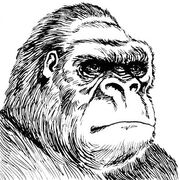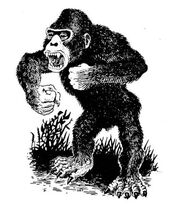Carnivorous apes were a breed of unusually large and aggressive ape, related to the gorilla[3][2][1] and distantly related to the yeti.[4][5][6][1]
Description[]
Resembling a gorilla, the carnivorous ape was rather bigger, standing 7 feet (2.1 meters) tall and quite broad.[3][2] They had bulky bodies with broad shoulders and long arms, but short legs. Normally quadrupedal, carnivorous apes practiced knuckle-walking. Both fingers and toes had black hooked claws. While they had black hair all over their bodies, the fur on their faces was light brown. Their nostrils flared and their mouths had long sharp teeth suited to cutting through flesh.[2] These fangs were similar to those of a hsing-sing.[7]
Abilities[]
Carnivorous apes possessed keen senses of hearing, smell, and eyesight, making them difficult to take by surprise.[3][2] They could have low-light vision.[1]
They were speedy climbers.[1] They swung on tree branches to move through the air almost as fast as they could on the ground.[2]
Tactics[]
In hunting, a typical tactic of the carnivorous ape was to stay out of sight itself up in the trees and pursue their prey, sometimes for miles. Finally, when their prey halted and was vulnerable, such as drinking from a stream, the ape would jump down and attack. If there were no trees, such as on plains, the ape would conceal itself behind a large bush or tall grass, then leap out.[2] They could be quite agile in a fight, leaping and attacking in one motion.[1]
They stood on their hind legs and fought with their arms. Carnivorous apes could attack with either their clawed hands or by biting. If they got both hands on their prey, they could rend their victims apart.[3][2][1]
To intimidate a trespasser or a defeated opponent, a carnivorous ape would stand upright and bellow loudly while pounding its hands on its chest.[2]
Behavior[]

A close-up of the head and face of a carnivorous ape.
These creatures were known to be fairly intelligent and quite cunning, but highly aggressive.[3][2] However, they typically only killed for food or to protect their families.[2] They even had a rudimentary language of their own, which some rare hobgoblins might know.[8][9][10] Carnivorous apes could communicate in a sign language.[11]
Ecology[]
Family Life[]
They lived in family groups of up to twenty members; females outnumbered males two-to-one. After a gestation period of nine months, the infants stayed with their mothers for the first three years of life, usually holding onto her fur and riding on her back when the family traveled.[2] Away from the family, groups of up to eight carnivorous apes were typically encountered away.[3][2]
The biggest male carnivorous ape led the family, decided what actions to take, and defended the group from aggressors. Sometimes a younger male challenged them for leadership, and the two wrestled for dominance; the duel was brutal but not deadly. The victor became the new leader, the loser departed in disgrace. While a defeated challenger sooner or later found a different family to join, a defeated leader stayed alone until death. Angry, bitter or frustrated, such former leaders were often the man-eating carnivorous apes of legend.[2]
The family had a consistent daily schedule. Shortly after sunrise, they ate their first meal of the day, after which the adults napped and the young played. During the day, the adult males went hunting and whatever prey they took they dragged back to share among the family. The second meal was had before sunset, and just after dark they went to sleep.[2]
They made their camps in hidden meadows or else in communal nests built in the canopies of high trees. However, they didn't lair anywhere for more than two nights in a row, always staying on the move around a home territory of some 10‒20 mi² (26‒52 km²). To mark the edge of this territory, the leader scratched a crude symbol in a tree trunk or sprayed a musk from a gland beneath their tongue.[2]
They collected coins and precious stones, and stashed these in hidden places, such as within hollow trees.[2]
Diet[]
As their name implied, these apes were a carnivorous species.[3] Their diet was largely the meat of rodents, small reptiles, and fish, supplemented with that of antelopes, buffalo, deer, and horses, which were their preferred prey in their hunts. Rarely, they scavenged carrion or caught a giant insect. They also ate eggs and enjoyed fruits and nuts.[2] They especially enjoyed the flesh of rohches, a wolf–beetle hybrid creature.[12]
While they were reputed to have a particular liking for human flesh,[3] this was mostly exaggerated. Only a rare few carnivorous ape families hunted humans exclusively, usually attacking groups of hunters or raiding villages. Man-eating carnivorous apes were more likely to be former leaders and other lone individuals, attacking out of rage or hunger.[2]
Habitats[]
Carnivorous apes were found in tropical climates, living in forests, jungles, hills, and plains.[2]
On Toril, in Faerûn, they could be found in the Forest of Amtar in the Shining South; there was a sizeable population and they were common in the northern forest.[13] In Kara-Tur, carnivorous apes lived in the jungles of the Kuong Kingdom in Malatra, where they were a threat to gem-hunters around Patayang in the mid–14th century DR.[14] In the Crowded Sea they inhabited a group of islands known as the Djinni's Claws.[15]
Beyond the Prime Material plane, they could also be found in the forests of the planar realm of Qui.[16]
Relations[]

A carnivorous ape beating its chest in an intimidating display.
Where game was abundant, carnivorous apes competed with other large predators such as lions. Prides of the big cats would even challenge and attack carnivorous ape families over territory and hunting rights, but the apes often moved away to avoid deaths among their kin.[2]
Some subterranean hobgoblin lairs could have up to a dozen carnivorous apes serving as guards[8][9] and some hobgoblin tribes kept them as fighting beasts.[17] Hobgoblin shamans of Nomog-Geaya saw the carnivorous ape as a favored animal, seeing its habits as similar to their own and admiring its savagery; to say one acted or fought like an ape was a compliment.[18]
A few primitive tribes required their members to slay a carnivorous ape as a rite of passage.[2]
Human sports hunters liked to target carnivorous apes and take trophies such as their heads, hands, and pelts.
History[]
A carnivorous ape was among a procession of captive beasts, monsters, and sentient beings led through the streets of Zhentil Keep in the Year of the Banner, 1368 DR, as part of a Cyricist religious festival.[19]
In Waterdeep, during Halaster's Higharvestide in the Year of the Gauntlet, 1369 DR, several carnivorous apes, along with other creatures and monsters escaped from Undermountain, might've been wandered through the Castle Ward and Trades Ward.[20]
Notable Carnivorous Apes[]
- Redeye, the pet carnivorous ape of the Lostafinga hobgoblin tribe of the Kryptgarden Forest[21]
- Mickey, Mike, and Pete, three trained carnivorous apes kept as guardians of the Davy Jones' Lock-Up in Ravens Bluff[22][23]
Appendix[]
See Also[]
Gallery[]
Appearances[]
Adventures
Novels & Short Stories
Card Games
Organized Play & Licensed Adventures
References[]
- ↑ 1.0 1.1 1.2 1.3 1.4 1.5 1.6 1.7 1.8 Christopher Perkins (December 2011). “Steading of the Hill Giant Chief”. In Steve Winter ed. Dungeon #197 (Wizards of the Coast) (197)., pp. 16, 18.
- ↑ 2.00 2.01 2.02 2.03 2.04 2.05 2.06 2.07 2.08 2.09 2.10 2.11 2.12 2.13 2.14 2.15 2.16 2.17 2.18 2.19 2.20 2.21 2.22 2.23 2.24 2.25 David "Zeb" Cook, et al. (1989). Monstrous Compendium Volume Two. (TSR, Inc). ISBN 0-8803-8753-X.
- ↑ 3.00 3.01 3.02 3.03 3.04 3.05 3.06 3.07 3.08 3.09 3.10 3.11 3.12 3.13 Gary Gygax (December 1977). Monster Manual, 1st edition. (TSR, Inc), p. 7. ISBN 0-935696-00-8.
- ↑ Doug Stewart (June 1993). Monstrous Manual. (TSR, Inc), p. 368. ISBN 1-5607-6619-0.
- ↑ James Wyatt (October 2001). Oriental Adventures (3rd edition). (Wizards of the Coast), p. 199. ISBN 0-7869-2015-7.
- ↑ Wolfgang Baur, James Jacobs, George Strayton (September 2004). Frostburn. Edited by Greg Collins. (Wizards of the Coast), p. 163. ISBN 0-7869-2896-4.
- ↑ Rick Swan (July 1990). Monstrous Compendium Kara-Tur Appendix. (TSR, Inc.), p. 28. ISBN 0-88038-851-X.
- ↑ 8.0 8.1 Gary Gygax (December 1977). Monster Manual, 1st edition. (TSR, Inc), pp. 52, 53. ISBN 0-935696-00-8.
- ↑ 9.0 9.1 Doug Stewart (June 1993). Monstrous Manual. (TSR, Inc), p. 191. ISBN 1-5607-6619-0.
- ↑ Bill Slavicsek (1993). The Complete Book of Humanoids. (TSR, Inc), p. 37. ISBN 1-5607-6611-5.
- ↑ Jean Rabe (June 1997). Going Ape. Living City (RPGA), pp. 3, 10.
- ↑ David Cook (1991). Monstrous Compendium Forgotten Realms Appendix (MC11). (TSR, Inc), p. Rohch. ISBN l-56076-111-3.
- ↑ Tom Prusa (1993). The Shining South. (TSR, Inc), p. 36. ISBN 1-56076-595-X.
- ↑ Mike Pondsmith, Jay Batista, Rick Swan, John Nephew, Deborah Christian (1988). Kara-Tur: The Eastern Realms (Volume II). (TSR, Inc), p. 102. ISBN 0-88038-608-8.
- ↑ David Cook (October 1992). “The Djinni's Claws”. In Bill Slavicsek ed. Golden Voyages (TSR, Inc.), p. 2. ISBN 978-1560763314.
- ↑ Rick Swan (1990). Test of the Samurai. (TSR, Inc), pp. 9, 49. ISBN 0-88038-775-0.
- ↑ Mike Mearls, Jeremy Crawford, Christopher Perkins (2014-09-30). Monster Manual 5th edition. Edited by Scott Fitzgerald Gray. (Wizards of the Coast), p. 186. ISBN 978-0786965614.
- ↑ Roger E. Moore (July 1982). “Point of View: The humanoids – Goals and gods of the kobolds, goblins, hobgoblins, & gnolls”. In Kim Mohan ed. Dragon #63 (TSR, Inc.), p. 30.
- ↑ James Lowder (August 1993). Prince of Lies. (Wizards of the Coast), chap. 12. ISBN 1-56076-626-3.
- ↑ Steven E. Schend (January 1997). Undermountain: Stardock. Edited by Bill Olmesdahl. (TSR, Inc.), p. Halaster's Harvestide Encounter Tables. ISBN 0-7869-0451-8.
- ↑ Paul Culotta (November/December 1990). “The Inheritance”. In Barbara G. Young ed. Dungeon #26 (TSR, Inc.) (26)., p. 10.
- ↑ Phillip A. Dyer, et al. (August 1991). Port of Ravens Bluff. Edited by Jean Rabe, Skip Williams, David Wise. (TSR, Inc.), p. 22. ISBN 1-56076-120-2.
- ↑ Ed Greenwood (October 1998). The City of Ravens Bluff. Edited by John D. Rateliff. (TSR, Inc.), p. 106. ISBN 0-7869-1195-6.

